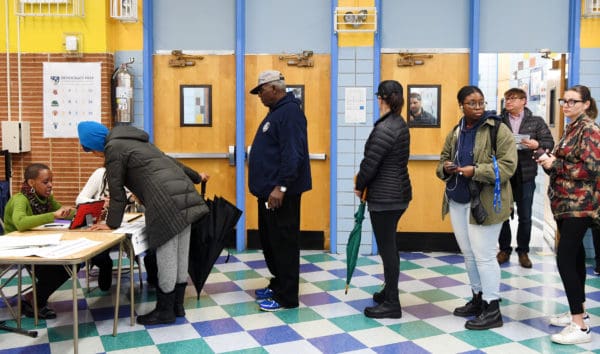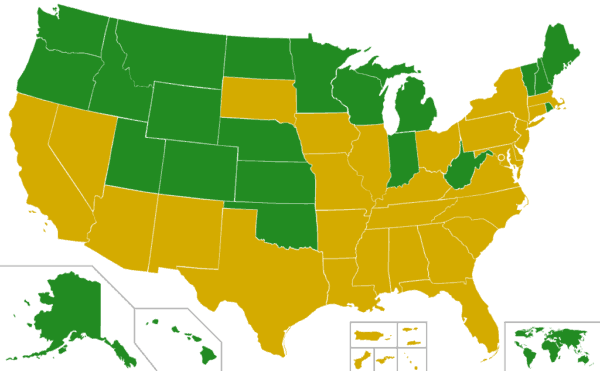Using Demographics to Predict Tuesday’s Primaries
Chris Roberts, American Renaissance, March 6, 2020

Voters register at a polling station in Manhattan. (Credit Image: © Li Rui / Xinhua via ZUMA Wire)
On Tuesday, March 10, six more states will pick Joe Biden or Bernie Sanders for the Democrat presidential nomination. They are: Idaho, Michigan, Mississippi, North Dakota, Missouri, and Washington. So far, the best predictor for who wins a Democrat contest has been race: the more blacks a state has, the more likely it is for Joe Biden to win, the more Hispanics and Asians, the more likely it is for Bernie Sanders to win. Whites are the most politically divided group, but generally, Mr. Sanders has won supermajority white states.
Based on that alone, one could make these predictions:
- North Dakota, 84 percent white and 3.4 percent black, will vote for Bernie Sanders — especially given that Mr. Sanders won it in 2016.
- Idaho, 82 percent white, 13 percent Hispanic, and only 1 percent black, will vote for Mr. Sanders — especially given that he won it in 2016.
- Washington, 68 percent white, 13 percent Hispanic, 9 percent Asian, and 4 percent black, will vote for Mr. Sanders — especially given that he won it in 2016.
- Mississippi, 38 percent black, will vote overwhelmingly for Joe Biden — just as South Carolina and Alabama did — especially given that Mr. Sanders lost it in 2016.
- Missouri, 79 percent white, 12 percent black, 4 percent Hispanic, and 2 percent Asian, will vote for Mr. Biden — especially given that Mr. Sanders lost it in 2016.
The factor that might make some of these predictions wrong — and why I have not yet addressed Michigan — is that Mr. Sanders is not doing as well with white voters as he did in 2016, when he narrowly won the white vote. One doesn’t even have to look at exit polls to notice this trend, just look at his share of the vote in supermajority states in 2016 versus 2020:
- Minnesota (76 percent white): Won by Mr. Sanders in 2016 with 62 percent of the vote, lost in 2020 with 30 percent of the vote.
- Maine (93 percent white): Won by Mr. Sanders in 2016 with 64 percent of the vote, lost in 2020 with 33 percent of the vote.
- New Hampshire (90 percent white): Won by Mr. Sanders in 2016 with 60 percent of the vote, won in 2020 with 27 percent of the vote.
- Iowa (85 percent white): Narrowly lost by Mr. Sanders in 2016 with 49.59 percent of the vote, effectively tied for first in 2020 with 26.5 percent of the vote in 2020.

The fight for the 2016 Democrat presidential nomination. Mr. Sanders’ victories are in green, and Mrs. Clinton’s are in yellow. (Credit: Wikimedia)
In the cases of New Hampshire and Iowa, Mr. Sanders only survived this drop because he faced a divided field. That is no longer the case. In 2020, he made up for his declining white vote share by improving his support among Hispanics and Asians, especially in California. That means that next Tuesday he will certainly win again in Washington, where Hispanics and Asians together will be at least one in three Democrat voters. There aren’t nearly enough black voters to cancel them out.
However, Idaho and North Dakota are not guaranteed victories. Senator Sanders is especially vulnerable in Idaho, because in 2016 it had a caucus, and this year, it will have a primary. Primaries are straightforward, you just go to your polling place and vote as you would in a general election. A caucus is more complicated. It is a miniature campaign that involves debating and multiple rounds of voting. It requires more dedication than a primary. Thus, a campaign with dedicated activists — such as Mr. Sanders’s — has an edge. Unfortunately for him, many states that were caucuses in 2016 are primaries in 2020 — and Mr. Sanders has suffered because of it. Both Minnesota and Maine were caucuses that Mr. Sanders won in 2016 and primaries that he lost in 2020. Idaho, which is demographically similar to Maine and Minnesota, was also a caucus in 2016, and will be a primary next week. Since North Dakota remains a caucus, it is hard to see Mr. Sanders losing it — but Idaho may prove to be yet another “surprising” win for Mr. Biden.
Finally, there is the state of Michigan. It is 75 percent white, 14 percent black, 5 percent Hispanic, and 3.5 percent Asian. It will be a primary this year, and was a primary in 2016. Mr. Sanders won it last time, with 49.68 percent of the vote to Hillary Clinton’s 48.26 percent. Interestingly, before the election, every poll indicated it would go to Mrs. Clinton. FiveThirtyEight.com gave her a 99 percent chance of winning the state, and after the results came in, said those erroneous predictions were “among the greatest polling errors in primary history.” It was another instance of Mr. Sanders being grossly underestimated. However, his dramatic slip in the white vote makes another Michigan victory very unlikely. In 2016, he offset his losses in the black metropolis of Detroit with votes from poor, rural, and working-class whites. Those are precisely the whites he has lost ground with in 2020. After Super Tuesday, the New York Times noted that Mr. Biden “carried much of the old, moderate rural vote that Mr. Sanders swept four years earlier.” Market Watch saw the same thing:
Sanders had been counting on working-class whites, many who live in rural areas or lack college degrees, to help propel him toward the Democratic nomination. Yet Biden more than held his own with both groups on Super Tuesday.
Biden won the rural vote in Alabama, Minnesota, North Carolina, Oklahoma, Tennessee and Virginia and just lost narrowly in Maine. And he and Sanders basically split the vote among whites without college degrees.
In Washington state, Asians and Hispanics can make up for those losses and then some. North Dakota being a caucus gives Mr. Sanders some security there as well. But Missouri, Michigan, and Idaho all have large numbers of exactly the kinds of voters Mr. Sanders has sacrificed in order to win more votes from non-whites. Moreover, the first two have plenty of blacks who will certainly be voting for Mr. Biden, and none have very many of the Hispanics and Asians that handed Mr. Sanders a victory in California. Idaho may well still go for Mr. Sanders — but not by much, and delegates are assigned proportionally. Missouri and Michigan look completely out of his reach.

White construction workers. A key part of Bernie Sanders’ coalition in 2016, but not in 2020. (Credit Image: Paul Keheler / Wikimedia)
The delegate total for Washington and North Dakota is 103. Mississippi and Missouri combined have 104. Michigan has 125 and Idaho has 20. The math is not looking good for Mr. Sanders. Until now, he has benefited from a divided opposition. His coalition of Asians and Hispanics in the West has delivered for him. Unfortunately for him, the demographic groups that don’t vote for Mr. Sanders have consolidated behind Mr. Biden. The Vermont Senator is quickly running out of states where his brown-yellow alliance can bring victory.
Barring a major gaffe during a debate or live speech on the part of Joe Biden (which is not out of the question), Mr. Sanders won’t be able to win the Democrat nomination until the Asian and Hispanic shares of the electorate rise considerably. The good news for Mr. Sanders is that this will happen over the next 25 years. The bad news is that Mr. Sanders is 78-years old.















